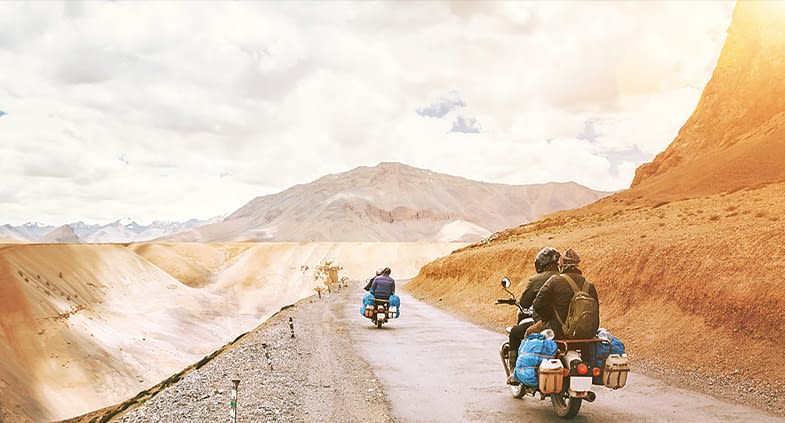Introduction
Visitors may enjoy some fantastic and thrilling hiking adventures in Ladakh. This area is a paradise for those looking for adventure among the peaks and slopes of the Himalayas. In Ladakh, there are several hiking alternatives with varying difficulty and time. While some treks take two weeks to complete, others may be finished in as little as three days. But on any of these walks, you’ll have great experiences.
A simple tour is an excellent option for beginners and families with young children. Still, those seeking a more challenging experience might choose a longer journey that crosses several passes over 5000 meters and even try the summit of a 6000-meter mountain.
We provide set departure treks for lone travelers and small groups that want to join a bigger group.
In Ladakh, May through October is the best month for trekking. However, specific hikes are only feasible beginning in early July because of the winter’s intense snowfall on the mountain passes. The Chadar walk on the frozen Zanskar river and the Snow Leopard trip are two treks organized in Ladakh from January to March each year and begin with the arrival of winter.
Top 4 Trek in Ladakh
Chadar frozen river trek:
The Chadar route serves as a lifeline for Zanskar, which is shut off from the rest of the nation in the winter owing to excessive snowfall.
Over time, the Chadar trek has become the “next big thing” in Ladakh, and it is easy to see why. The trekkers’ endurance is tested as they traverse the 105 miles of the frozen Zanskar River in mind-numbing conditions (-25 to -35 degrees). Few hikes pass through gorges with frozen waterfalls cling to an ice path that transforms into a sky-reflecting mirror. Documentaries have been made about the Chadar journey, notably the BBC’s “Human Planet” series from 2011.
Best time: January and February
Difficulty: level 3
Markha valley trek
The Markha Valley Trek in the Hemis National Park is the most well-known trek in Ladakh. The Markha valley, which follows the Indus river, divides the snow-capped Stok Kangri peak to the north from the Zanskar range to the south. On this walk, you will encounter stunning mountain landscapes, exotic animals, and tiny, secluded settlements around lush barley fields. You will get to stay in homestays in these areas and learn about the locals’ way of life.
The walk takes 6 to 8 days to complete depending on the beginning place. The Markha valley may be reached in two different ways: one from Spituk and the other from Chilling. The most extended option is the journey from Spituk. The hike concludes in Hemis after passing through the Ganda La (4961m), and Kongmaru La (5260m) passes. If you don’t have time or wish to avoid the Ganda La pass, there is an easier and faster-starting place.
Best time: end of April to the beginning of October
Difficulty: level 3
Nubra valley trek
The hike connects the Indus and Nubra valley from Phyang to Hunder. It follows a historic trade route formerly a part of the network of the Silk Roads, which connected Central Asia to India. Even in the summer, the Laser La pass, the highest point of this off-the-beaten-path hike, at 5438 meters, is constantly coated in ice and snow. A breathtaking view of the Karakoram mountains may be had from the pass.
After your journey, you’ll visit the main sights in the Nubra valley. At the Hunder Sand Dunes, you may ride a double-humped Bactrian camel and view the 32-meter-tall Maitreya Buddha statue located at the Diskit Monastery. After that, you’ll take the Khardung La to return to Leh.
Best time: mid-July to the end of September
Difficulty: level 3
Rumtse to Tso Moriri trek
You should climb from Rumtse to Tsomoriri if you appreciate taking in the gorgeous environment. This climb is among the wildest and most beautiful in Ladakh. This seven-day walk takes you over Changthang’s high-altitude plateau (Rupshu). The region has unique topography; when you traverse six passes above 5000 meters, you will encounter mountains with various textures and colors. Ladakh is a freezing desert but boasts several stunning lakes that tourists may enjoy. During your trek, you will get the opportunity to view the gorgeous Tso Kar and Tso Moriri lakes.
The first night in Kyamar is at an elevation of 4500 meters, and the next six days are constantly between 4500 and 5500 meters. This journey swiftly ascends to a very high altitude. As a result, it’s crucial to be well acclimated to the altitude before beginning the climb.
The Changthang plateau is home to the yak and pashmina goat herds that the Changpa nomads maintain. Since they relocate 8 to 10 times every year, it is hard to know in advance where their camp will be. If you’re lucky, you could stumble across some nomads along the route and be invited to their yak-wool tent to have some butter tea. The main hamlet in the region and the center of Changpa is Korzok. The sapphire-blue lake of Tso Moriri is not far from our wonderful walk-in site.
Best time: mid-June to mid-October
Difficulty: level 4


